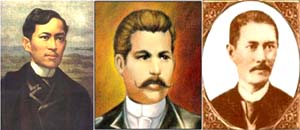Philippine Literature and the History of Philippine Literature
The Philippines is not only known in terms of its beauty, culture, and natural resources. Philippine authors have also paved their way to popularity during the history of Philippine Literature. They have written in Spanish, Filipino, English, and other native Philippine languages.
Epic poems, proverbs, songs, and riddles were passed from generation to generation through recitals and spells in various dialects of the islands.
The history of Philippine literature shows that a common theme of an epic is when a hero is being helped by good spirits. Many Philippine movie actors re-enact epics. Spirits help them seek justice and overthrow evil forces.
Shorter narratives that tell the origins of the people, the stars, the sky and the seas came to existence. A famous story that tells of the origin of man and woman is that of Sicalac (man) and Sicavay (woman) who came out of a bamboo after being pecked by a bird.
The first Filipino poet, Francisco Baltazar, wrote poems in Tagalog. His best-known work, Florante at Laura (Florante and Laura), is an epic poem that criticizes Spanish autocracy.
Philippine national hero, Dr. José Rizal, produced his own Panitikang Pilipino (Philippine literature) masterpiece in Spanish. Rizal’s novel Noli Me Tangere (Touch Me Not), published in 1886, and its sequel, El Filibusterismo (The Subversive), published in 1891, helped to shape a new, nationalist identity during the last years of the 19th century.

Jose Rizal, Marcelo del Pilar, Graciano Lopez Jaena Philippine Literature (Panitikang Pilipino) Icons
In 1898, the United States took control of the Philippines resulting in a dramatic increase in literacy and, consequently, literary production.
A variety of new literary journals began to be published. English-language Filipino novels, short stories, and poems were first published in book form in the 1920s.
Many Filipino authors have had distinguished writing careers. Their works typically explore the Filipino cultural identity in the context of social and political issues.
During the American occupation, most of the Philippine literature written in Spanish was made by Philippine scholars.
One of the Philippines' famous writers, Claro M. Recto, continued writing in Spanish. Other well-known Spanish language writers were Isidro Marfori, Cecilio Apostol, Fernando Guerrero, Flavio Zaragoza Cano, Jesús Balmori, Enrique Fernandez Lumba, and Francisco Zaragoza.
Other epics in the history of Philippine literature which are known to most Filipinos are the Ibalon of Bikol, Darangan which is a Muslim epic, the Kudaman of Palawan, the Alim of the Ifugao, Bantugan of the Maranao, the Hinilawod of Panay, the and the Tuwaang of Manobos.
The Tagalogs pride their Myth of Bernardo Carpio, a folk hero said to hold the mountains of San Mateo apart with his powerful arms to prevent them from colliding.
Nowadays, Filipino writers have continued to patronize the intellectual influence and Philippine literature, or panitikang Pilipino, started by the likes of Rizal but to further aim at reviving the richness of the country’s very own folk traditions and introducing it to new generations as a significant form of art.


